George Augustine Hyde led the first known church to openly minister to and with homosexuals in the U.S. Hyde was born on July 2, 1923, in Chattanooga, Tennessee. His family moved to Atlanta when he was around three years of age. Hyde contracted polio as a child but recovered from that after several years of treatment and surgery.
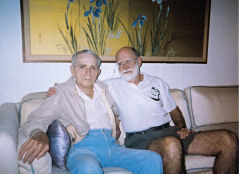 With LGBT-RAN Advisory Committee member Jim Anderson at Hyde's home in Bellaire, Florida, in January, 2005Even though raised in the Southern Baptist church his family attended, Hyde became increasingly interested in Roman and Orthodox churches as a youth. He decided to enroll in seminary and study for the Roman Catholic priesthood. Atlanta bishop Gerald O’Hara sponsored Hyde to enroll in St. Mary’s Seminary in Perryville, Missouri. Hyde found the adjustment to seminary life difficult and, upon being accused of immoral same-sex conduct by a fellow student, was dismissed from the seminary.
With LGBT-RAN Advisory Committee member Jim Anderson at Hyde's home in Bellaire, Florida, in January, 2005Even though raised in the Southern Baptist church his family attended, Hyde became increasingly interested in Roman and Orthodox churches as a youth. He decided to enroll in seminary and study for the Roman Catholic priesthood. Atlanta bishop Gerald O’Hara sponsored Hyde to enroll in St. Mary’s Seminary in Perryville, Missouri. Hyde found the adjustment to seminary life difficult and, upon being accused of immoral same-sex conduct by a fellow student, was dismissed from the seminary.
Returning to Atlanta, Hyde became a public high school teacher. During this time he met John Augustine Kazantks, a bishop in the Greek Orthodox Church, who had been cast out of his church position and left Greece after being accused of being homosexual. Hyde also spent time at Sacred Heart Church in downtown Atlanta where he soon developed what he calls “a rather unique outreach.” Upon learning from priests there that a young male parishioner had confessed to homosexual behavior, refused to admit that this was an “abomination” and, therefore, was being denied Communion, Hyde reacted. He organized a series of silent protests during Mass for several weeks. During the month of June, 1946, bi-weekly “informational and educational programs” were begun, conducted by both Kazantks and Hyde, designed to prepare those in quest for an ecclesiastical life outside the Roman and other “institutional churches." The first formal gathering of the new parish was held on July 1, 1946, the occasion being the ordination of Hyde to the priesthood at the hands of Bishop Kazantks. This gathering was held in a meeting room of the Winecoff Hotel in Atlanta. This particular meeting room, the rental of which was underwritten by the management of the Cotton Blossom Room, a gay bar in the same hotel, was to house the activities of the nascent congregation from June to December, 1946. In late November 1946, the emerging congregation rented a large residence near the downtown business district for housing a chapel and living quarters for the local clergy. Educational and instructional classes continued to meet at the Winecoff Hotel until it was destroyed by fire on December 7, 1946.
 Celebrating mass in Miami in 1997Through working with the gay and lesbian community in Atlanta, contacts were made with a number of gay and lesbian people across Georgia who desired to relate to an accepting church. In January 1947, Bishop Kazantks moved to Savannah, Georgia, and from his home there maintained a ministry to a scattered flock across southern Georgia, while Hyde did the same in Atlanta and the northern half of the state. Over the next decade the church experienced a reasonably steady growth. The original (1946) congregation of about 85 people had grown to a total of more than 200 people by the end of 1947.
Celebrating mass in Miami in 1997Through working with the gay and lesbian community in Atlanta, contacts were made with a number of gay and lesbian people across Georgia who desired to relate to an accepting church. In January 1947, Bishop Kazantks moved to Savannah, Georgia, and from his home there maintained a ministry to a scattered flock across southern Georgia, while Hyde did the same in Atlanta and the northern half of the state. Over the next decade the church experienced a reasonably steady growth. The original (1946) congregation of about 85 people had grown to a total of more than 200 people by the end of 1947.
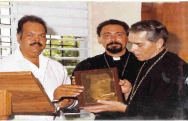 Being presented key to the City of Fajardo by Mayor Emillio Pacheco with Fr. Nicholas Reyes, pastor of St. George Church in Fajardo, Puerto Rico, in 1982Hyde moved to Washington, D.C., in 1950, where he joined some colleagues in a worker-priest community called “The Society of Domestic Missionaries.” As workers in various secular jobs the Domestic Missionaries “took the church to where the people were”. A secondary “benefit” was that their secular salaries went toward the support of the ministry-church. The present day practice of the Holiday Inn (motel chain) providing an “on call chaplain” for its guests was started in the early 1960's by a Domestic Missionary whose secular occupation was as desk clerk at a Washington, D.C., Holiday Inn.and movement.
Being presented key to the City of Fajardo by Mayor Emillio Pacheco with Fr. Nicholas Reyes, pastor of St. George Church in Fajardo, Puerto Rico, in 1982Hyde moved to Washington, D.C., in 1950, where he joined some colleagues in a worker-priest community called “The Society of Domestic Missionaries.” As workers in various secular jobs the Domestic Missionaries “took the church to where the people were”. A secondary “benefit” was that their secular salaries went toward the support of the ministry-church. The present day practice of the Holiday Inn (motel chain) providing an “on call chaplain” for its guests was started in the early 1960's by a Domestic Missionary whose secular occupation was as desk clerk at a Washington, D.C., Holiday Inn.and movement.
Kazantks expressed his desire to return to Greece and did so in 1957, dying later that year. Prior to his leaving he put Hyde in touch with Archbishop Clement Sherwood (1895-1969) of the American Holy Orthodox Catholic and Apostolic Eastern Church in New York. Hyde was impressed that Sherwood embraced him despite knowing that a large number of his parishioners were homosexual. Sherwood devised a special theological education program for Hyde. After three years of rather intense tutoring, Sherwood consecrated Hyde as a bishop on May 7, 1957. assisted by Bishop Maurice Francis Parkin and William Ernest James Robertson.
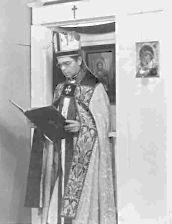 At Holy Transfiguration Church in Houston, Texas, 1976It has been erroneously reported by some sources that shortly after his consecration Hyde split with Sherwood over Eastern vs. Western liturgical practices and that, in 1960, Hyde formed his own church, i.e. the Orthodox Catholic Church of America. This is incorrect. While it is true that a brief disagreement did surface that negatively impacted the harmonious fellowship previously existing between Sherwood and Hyde, there was no formal schism. Subsequently, Sherwood designated Hyde as “Bishop of the Western Rite Missions” of the American-Eastern Orthodox Church” and charged him to accelerate Clement’s own long-time plan for all of the Bishoprics of the American-Eastern Church to cut their identity ties with Greece, Russia, the Balkans, the Middle East and to identify themselves as members of an indigenous American Church under the title of the “Orthodox Catholic Church of America.” This divesting of the assortment of ethnic bishoprics of their national identities was not very successful. Archbishop Clement Sherwood died April 9, 1969, with Hyde being elected in 1970 as his successor. With this event the nationally-defined ethnic Bishops (Russian, Greek, Ukrainian, etc.) went into schism, taking with them about eight thousand people and scores of clergy and churches, rather than to conform to the name change to Orthodox Catholic Church of America which they felt Hyde would now force upon them.
At Holy Transfiguration Church in Houston, Texas, 1976It has been erroneously reported by some sources that shortly after his consecration Hyde split with Sherwood over Eastern vs. Western liturgical practices and that, in 1960, Hyde formed his own church, i.e. the Orthodox Catholic Church of America. This is incorrect. While it is true that a brief disagreement did surface that negatively impacted the harmonious fellowship previously existing between Sherwood and Hyde, there was no formal schism. Subsequently, Sherwood designated Hyde as “Bishop of the Western Rite Missions” of the American-Eastern Orthodox Church” and charged him to accelerate Clement’s own long-time plan for all of the Bishoprics of the American-Eastern Church to cut their identity ties with Greece, Russia, the Balkans, the Middle East and to identify themselves as members of an indigenous American Church under the title of the “Orthodox Catholic Church of America.” This divesting of the assortment of ethnic bishoprics of their national identities was not very successful. Archbishop Clement Sherwood died April 9, 1969, with Hyde being elected in 1970 as his successor. With this event the nationally-defined ethnic Bishops (Russian, Greek, Ukrainian, etc.) went into schism, taking with them about eight thousand people and scores of clergy and churches, rather than to conform to the name change to Orthodox Catholic Church of America which they felt Hyde would now force upon them.
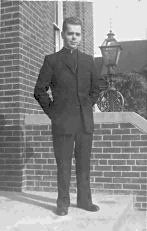 Outside St. Peter and Paul Church in
Outside St. Peter and Paul Church in
Springfield, Mass., site of 1957 synodThe Orthodox Catholic Church of America, while having an active pastoral outreach to gay people as members and priests, was never exclusively a “gay church”, just as it was never a “black church” because of its pastoral outreach into the black community. As a pastor Hyde not infrequently chided his congregation, “if kneeling side by side in prayer next to a black person or a gay person is a problem, know that it is you who has a problem, not them." However, in 1969, Hyde encouraged and worked with the Reverend Robert Clement in nurturing his founding of a gay-oriented parish in New York’s Greenwich Village, that was administratively known as the Eucharistic Catholic Church with its New York parish being known as the Church of the Beloved Disciple. This congregation eventually numbered about 500 people. Clement was consecrated Bishop in 1974 and subsequently expanded the Eucharistic Catholic Ministry into Canada.
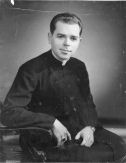 George Augustine Hyde, OCCA bishop of Washington-Atlanta in 1957 Archbishop Hyde retired for health reasons in 1983 and was succeeded as Archbishop of the Orthodox Catholic Church of America by Bishop Alfred Lankenau of Indianapolis, Indiana. In 1995, Lankenau and the Orthodox Catholic Church of America decided to ordain women. Hyde disapproved of the decision, and when subsequently approached by a small group of priests and members who also disapproved of female priests, he came out of retirement so as to address and serve their liturgical, sacramental, and spiritual needs. Hyde and his constituency incorporated in the State of Florida as the Autocephalous Orthodox Catholic Church of America. In common usage they are known as the Orthodox Catholic Archdiocese and Metropolitanate of America, the territorial and jurisdictional name originally given by the Patriarch of the historic Syrian Orthodox Church of Antioch to the American Orthodox Catholic Church upon the consecration of its first bishop in 1892.
George Augustine Hyde, OCCA bishop of Washington-Atlanta in 1957 Archbishop Hyde retired for health reasons in 1983 and was succeeded as Archbishop of the Orthodox Catholic Church of America by Bishop Alfred Lankenau of Indianapolis, Indiana. In 1995, Lankenau and the Orthodox Catholic Church of America decided to ordain women. Hyde disapproved of the decision, and when subsequently approached by a small group of priests and members who also disapproved of female priests, he came out of retirement so as to address and serve their liturgical, sacramental, and spiritual needs. Hyde and his constituency incorporated in the State of Florida as the Autocephalous Orthodox Catholic Church of America. In common usage they are known as the Orthodox Catholic Archdiocese and Metropolitanate of America, the territorial and jurisdictional name originally given by the Patriarch of the historic Syrian Orthodox Church of Antioch to the American Orthodox Catholic Church upon the consecration of its first bishop in 1892.
Hyde spent the last years of his life living in Belleair, Florida. He died on May 4, 2010. He was cremated and his ashes buried in his family plot in Marietta, Georgia.
_________________
Sources: Archbishop George Augustine (Hyde) c. 2004; J. Gordon Melton; the “Eucharistic Catholic Church (Canadian Branch)” posted at http://netministries.org/see/churches/ch04614, accessed September 15, 2004; Ward, Gary L., ed. “Independent Bishops: An Independent Directory”. Detroit, MI, Apogee Books, 1990; “Genesis of the Orthodox Catholic Church of America” a history of the OCCA by Archbishop George Hyde, edited by Fr. Gordon Fischer, 1993, www.orthodoxcatholicchurch.org/history.html.
Biography Date: September, 2004
“Rev. George Augustine Hyde | Oral History”, LGBTQ Religious Archives Network, accessed April 18, 2024, https://lgbtqreligiousarchives.org/oral-histories/george-augustine-hyde.